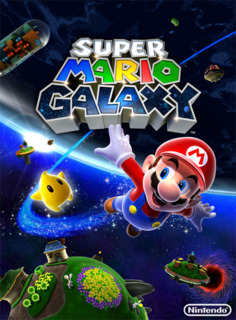Mario leaves Mushroom Kingdom behind, and sets foot in the deep dark reaches of space in this new galactic adventure
Super Mario Galaxy starts off with a little story-telling explaining how a comet passes over Mushroom Kingdom every 100 years and drops starbits upon the world. Princess Peach has invited Mario to her castle to see this rare occurrence and to give him a gift of some sort. As everyone is celebrating the festival, Bowser makes his appearance by attacking the kingdom with his airships (Super Mario Bros. 3). He once again captures the princess and inexplicably warps into space taking Peach's entire castle with him. Mario, of course gives chase but ends up being knocked out and sent to a small planet. Mario regains consciousness and is meet by Lumas, star-like creatures who yes look like frozen, headless chickens. The Lumas take Mario to meet Rosalina. Mario is informed that the universe is in danger, and is asked to free all the stars and to stop Bowser. Thus begins Mario's great adventure through space.
Controls are more or less the than the same than the previous titles. Some new controls are the motion based ones such as the spin attack. The spin attack is activated with a simple flick of the wrist, and is highly responsive. The spin attack will be used a lot in the game, as it is used to defeat enemies, and many other actions. After use a short pause is needed before you can use the attack again, a simple but effective tweak to make the spin attack not so overpowered. Pointing at the screen with the Wii Remote will cause a cursor to appear, this cursor is used for collecting starbits. Starbits can also be used as weapons, point the cursor at enemies the fire with the B button, this causes enemies to be temporarily stunned. Shooting starbits is sometimes enjoyable, but doesn't always work which makes them forgettable to use, also the spin attack is far more useful.
Mario's health has been shortened down to just 3 hits, and just like Super Mario 64 coins can be collected to restore health. Defeating enemies certain ways sometimes results in different rewards. Such as jumping on a Goomba will give you a coin, whereas spin attacking it will result in starbits. This is a unique and great way for you to choose how to defeat your enemies. So to say this game is pretty well balanced. The camera is a little pesky, and manually moving it is tricky. If you move it manually it will most likely move to far never really finding that perfect spot, I found out that it is unavailable to move in a lot of areas. Thankfully pressing C will center the camera behind you. Pressing up will let you view the world through Mario's eyes, which is helpful for looking for specific items or to just appreciate the amazing and lush visuals of Super Mario Galaxy.
The coolest and most infuriating aspect of Super Mario Galaxy's gameplay is gravity. As you travel through the many small planets that are apart of the galaxy you will notice that they have their own gravity. Meaning you can walk underneath the planet without falling off. When this happens the controls suddenly get reversed, which is the infuriating part. You will find your self in confusing angles on a planet with even more confusing controls, which makes avoiding cannonballs, enemies, and falling off extremely difficult. While a great new feature it needs improvement.
Super Mario Galaxy is somewhat fast-pace as you are mainly shooting around from planet to planet within the galaxy until you reach or complete your objective. Some parts of the game consist of 2-D sidescrolling, a welcomed surprise. The boss battles while fun are far too easy, the most difficult part is actually getting to the boss. There are 7 power-ups in total which will help Mario on his journey some more so than others *cough*Spring Mushroom*cough*. Most where fun to use but others where just plain annoying. Whether you like them or not they are needed to collect the stars. Now to the most impressive part of Super Mario Galaxy, the graphics. For a Wii title the graphics are pretty impressive, but its much more than just that. When you are shooting out of an exploding volcano flying to the next planet you cant just help but stop and stare at the amazing visuals, you see lava shooting up, and a trail of starbits waiting to be collected, nice. Equally amazing is the very few cut-scenes you see. The music was enjoyable and hearing the old famous soundtracks from old games was great too, brought back a whole wave of nostalgia.
The hub is large and explorable, 1-ups can even be found here. The more stars you bring back to the hub and the more areas you can explore, you will also unlock more of Rosalina's stories. The amount of content and secrets in this game is massive, collect all 120 stars to see for yourself. Later in the game you are introduced to comets, which add difficulty to an already completed level, the reward being another star. These comets come in a different variety some make you complete a level in a given time and some make you make you defeat a boss without losing health. You don't have to complete any comets to get to the 60 stars needed to fight Bowser. Collecting all 120 stars is a true test to a gamer's skill and sanity, such as the purple coin levels. Comets only bring a small change to the levels, and replaying these levels only increases the repetitiveness. Collecting all 120 stars wasn't as fun as it was in Super Mario Sunshine.
Final notes:
> Amazing visuals and cut-scenes
> Super Mario Galaxy is a lengthy adventure with plenty of extras
> Good and bad power-ups
> Easy Bosses
> Repeating levels
> Difficult gravity controls

